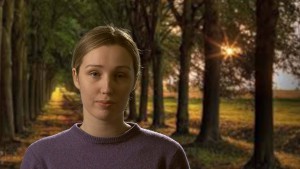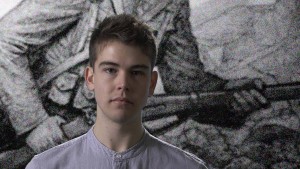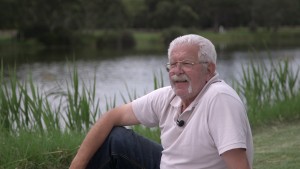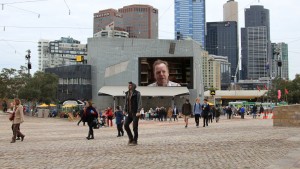This is the first in a series of blog posts exploring stories of research, looking at what the historic urban landscape might mean for different research and storytelling projects.
Lucinda Horrocks is one half of Wind & Sky Productions, a Ballarat based independent film production company specialising in short form documentaries, and she joins us here for a Q&A.
The key concept behind the Historic Urban Landscape (HUL) and Visualising Ballarat portals is to provide different lenses with which to view the city and region. As storytellers, Wind & Sky explore ways of presenting multiple perspectives in compelling “big ideas for the small screen.”
You have worked on/are working on a couple of interesting historical projects connected to Federation University Australia- can you talk a bit about Seeing the Land from an Aboriginal Canoe and Memories of War? And how have the processes differed?
‘Seeing the Land from an Aboriginal Canoe’ is a film and multimedia project about a forgotten history of encounters between Aboriginal Victorians and settlers on the rivers of Victoria in the 1800s. The FedUni connection is that the project was inspired by the research of Associate Professor Fred Cahir, who was struck by the everyday use of bark canoes in Victoria in the 19th century, and the reliance European settlers had on Aboriginal technology and skills in that period. The project, which is hosted on Culture Victoria, features interviews with Fred Cahir and Traditional Owners Uncle Bryon Powell, Jamie Lowe and Rick Nelson, and includes artwork, maps and photographs from the regional and metropolitan collections of the State Library of Victoria, the Art Gallery of Ballarat, Public Record Office Victoria, Museum Victoria and the Ballarat Gold Museum. More here.
‘Memories of War’ is a collaborative project now in progress between Wind & Sky, Ballarat RSL, FedUni, the Gold Museum and M.A.D.E Ballarat. It commemorates the centenary of WW1 in Ballarat by exploring the connections young Ballarat people today have to events that took place a hundred years ago. A number of writing, history, arts and education students at FedUni have gone through a process of understanding WW1 this year and they are going to share their stories on a specially developed blog run by the Ballarat Gold Museum. We at Wind & Sky are producing a documentary film about the student journey and that is going to be shown at M.A.D.E Ballarat in a special screening and Q&A event on the 8 November. More info at: http://mow.windsky.com.au/
Alisha Eddy and Nick Murphy, actors from Federation University taking part in the Memories of War film project
I suppose the subject matter for each project is different, but for each project we are trying to work through a process of discovering the heart of a story behind the bare facts of history. With the canoe project that involved working closely with Fred to identify core stories but also required reaching out to Aboriginal communities to try and understand what that history means in today’s context. And that took a lot of time and listening. It’s a very subtle thing creating a documentary, it’s very collaborative, you try to let people speak for themselves, yet provide some framework and structure so it all ties together into a narrative. There’s a lot of work in getting it right, and we don’t always get it right. The ‘Memories of War’ project is complicated by the uncertain nature of it – we’re not sure how many students will choose to participate in the blog project, we’re not sure what we’re going to get. But then we’re never sure what we’re going to get in the end. That’s what makes it an exploration rather than an exposition.
What does the historic urban landscape mean to you in projects like these?
This is a tough question to answer. I’m not sure I know what historic urban landscape means. Places change over time and often the landscape that we cherish today as historical doesn’t actually relate that well to the historical story we cherish. And what does urban mean when you are talking about places of history? What is a city now wasn’t always. Look at the landscape of the 1850s and the Eureka Stockade for example – it must have been a big riotous tent city in a devastated and dug up environment. It was probably quite ugly and not much to do with the urban environment we see today or even the grand buildings of Ballarat we think of as iconic. Urbanisation is an overlay that can add interest and diversity to a place but also threaten older landscapes and buildings. Cities are constantly rewriting their landscape and rewriting their histories. It’s an incredibly complex thing. Sometimes we play around with this complexity in our films.
With the canoe project we went to some very specific locations which were significant for the stories Fred had unearthed and for the traditional owners who spoke about them. Some were urban and some weren’t. For example we interviewed Uncle Bryon Powell, Wadawurrung Elder, on the banks of the Barwon River in the centre of Geelong, which is now very built up and vastly different from the story of what that place was like in the 1800s. But that for us was an interesting juxtaposition, to sit on that genteel river edge where they have ‘Henley on the Barwon’ today and imagine another landscape where the banks were lined with River Red Gums and Wadawurrung people relied on the resources of the river and the forest and interacted with explorers and squatters, and each group wanted to manage that landscape differently.
Uncle Bryon Powell by the Barwon River and Professor Fred Cahir on screen at Federation Square
How do you think the stories and memories of a city connect to the physical landscape?
Can a city have a memory? That’s an interesting question. So many people pass through cities at different times and there are a multitude of memories and stories and perspectives about them, some ancient, some recent, some dark and uncomfortable, most of them unknown, some celebrated, many of them historically wrong. I think places with stories are powerful. Look at the Pyramids or Stonehenge. They are powerful because of what they are, but also because writers have written about them for centuries and we know, or think we know, their story. Look at Hanging Rock. It’s a beautiful place but made so much more significant for many Australians after Joan Linsday’s novel and Peter Weir’s film. I suppose the Pyramids and Stonehenge and Hanging Rock are landmarks. Cities themselves are more complex and the landscape of a city is complex, I think. It’s difficult to answer.
How does making this sort of work change your perspective on the city and its history?
I am drawn to projects which make me think ‘I had no idea that happened’. So I suppose every story I work on enhances my knowledge of a place. History is surprising in that you think you know what happened. You are so confident you know it. But scratch the surface of a common story and you find you barely know a thing. The history of Aboriginal people in the foundation of Ballarat for instance – I went to school here and my schooling taught me that Aboriginal people were in Ballarat in ancient times but after settlement they faded out of the picture, more or less without any influence on the future of the city. To discover that Aboriginal people are alive in our history, that they were active participants in the events and foundation of this city, that they adapted and endured and influenced, and to realise the extent of their influence on our towns and exploration patterns and inhabitation patterns, that was a big surprise to me. A good surprise.
What role does collaboration play in your work? What do you think comes out of this?
We like collaborating. Well, I say ‘like’. It is scary to begin it sometimes because you have to learn to give up some of your creative control and listen to other ideas on what is important and how something should be done. So there’s a lot of preparation and groundwork needed in collaboration, setting up how you are all going to work together and how you are going to do things. But it’s very important to us. Difficult, scary, time-consuming but a lot of fun and hugely important for the outcome of projects. Through collaboration you get those different perspectives, those transformative moments that are so magic when they arrive.
-Amy Tsilemanis






1 thought on “Stories Bringing New Perspectives”